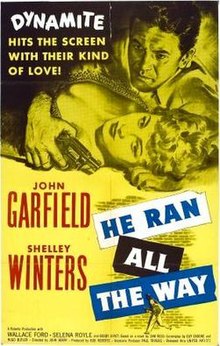A well-mounted film noir, John Berry’s He Ran All the Way is best known today for featuring John Garfield in his last role (he would die of fatal heart attack the following year).
Grade: B (**** out of *****)
| He Ran All the Way | |
|---|---|

Theatrical release poster
|
|
Garfield plays Nick Robey, a petty thief who botches a robbery, leaving behind his wounded partner Al (Norman Lloyd), and then escaping with over $10,000.
He meets an innocent bakery worker, Peg Dobbs (Shelley Winters), at a swimming pool, and he offers to take her home. After some small talk and awkward dancing, his mood darkens and he decides to take the family hostage until he can escape.
During the film’s initial run, director John Berry and writers Dalton Trumbo and Hugo Butler were uncredited due to their being blacklisting in Hollywood during the Red Scare.
Berry went into exile in France after finishing the film, and returned to the U.S. two decades later; he died in 1999.
In the same year, Shelley Winters played another naïve working-class femme, in George Stevens’ A Place in the Sun, for which she earned her first Oscar nomination (in the lead category).
Narratively, this film noir deals with a family entrapped in its own home by a criminal, a theme that would become more prevalent later in the decade, in such films as The Desperate Hours, a superior noir starring Bogart and Fredric March.
As the fugitive, Garfield is at his grimmest best, rendering a stark performance, defined by moments of desperation and self-pity.
Watch the scene in which Nick dances with Peg in her apartment, holding her so tight she can hardly breath or move. When she suggests another way of dancing, he just quits; every move must be on his own terms. Troubled to the core, deep down he feels sorry for himself, though on the surface, he appears to be tough and self-confident.
Nick has lost all touch with reality and “normal” life, and he can’t even perceive, let along respond to the good intentions of a decent girl like Peg, who really cares about him (she buys a seductive dress and fixes her hair) despite the dire circumstances.
James Wong Howe’s superb black-and-white cinematography draws on smoothly effective imagery of confined space; most of the tale is set indoors, within the limitations of one room.
The precise use of lighting in the intimate dialogue scenes, and the mega close-ups of the troubked Nick contribute to the overall sense of tension and unease.
The scene in which the family refuses to eat dinner, and is forced to do so at a gun point (which he fires) is particularly striking.
Franz Waxman’s understated yet ominous score, and the other production values, succeeds in elevating a rather standard plot above its familiar trappings.
Cast
John Garfield as Nick Robey
Shelley Winters as Peg Dobbs
Wallace Ford as Mr. Dobbs
Selena Royle as Mrs. Dobbs
Gladys George as Mrs. Robey
Norman Lloyd as Al Molin
Bobby Hyatt as Tommy Dobbs
Keith Hetherington as Captain of Detectives
Credits:
Directed by John Berry
Produced by Bob Roberts
Screenplay by Hugo Butler and Dalton Trumbo, based on He Ran All the Way, 1947 novel by Sam Ross
Music by Franz Waxman
Cinematography James Wong Howe
Edited by Francis D. Lyon
Production company: Roberts Pictures
Distributed by United Artists
Release date: June 19, 1951
Running time: 78 minutes
Box office: $1 million
Garfield’s Last Year
On May 9, 1952, Garfield moved out of his New York apartment, telling columnist Earl Wilson that he would soon be divorced. Close friends speculated that it was his wife’s opposition to his plotted confession in Look magazine that triggered their separation.
Upon hearing that a HUAC investigator was reviewing his testimony for possible perjury charges. His agent reported that 20th Century-Fox wanted him for a film called “Taxi,” but it would not begin talks unless the investigation concluded in his favor.
Significantly, three of his actor friends–Canada Lee, Mady Christians and J. Edward Bromberg00d–had all recently died after being listed by the HUAC committee.
On May 20, against his doctor’s orders, Garfield played tennis with a friend. He then met actress Iris Whitney for dinner, after which he became suddenly ill. Iris brought him to her apartment where he refused to call a doctor, and instead went to bed. The next morning, she found him dead.
Long-term heart problems, aggravated by the stress of blacklisting, had led to his death at the age of 39. The funeral was on of the the largest in New York City since that of Rudolph Valentino.
Ironically, shortly after his death, the HUAC closed its investigation of Garfield. His wife, Roberta Seidman, whom he married in 1935, had been a member of the Communist Party, but there was no evidence that Garfield himself had ever been a Communist.










